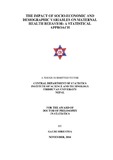Please use this identifier to cite or link to this item:
http://archive.nnl.gov.np:8080/handle/123456789/35| Title: | THE IMPACT OF SOCIO-ECONOMIC AND DEMOGRAPHIC VARIABLES ON MATERNAL HEALTH BEHAVIOR: A STATISTICAL APPROACH |
| Authors: | SHRESTHA, GAURI |
| Keywords: | STATISTICS logistic regression; odds ratio; multinomial logistic regression; proportional odds; partial proportional odds |
| Issue Date: | 26-Mar-2019 |
| Abstract: | Maternal health care is a crucial part of any health care system. Health care that a woman receives during pregnancy, at the time of child birth and soon after, is important for the survival and well-being of mother and the new born. The purpose of this study is to investigate the social, economic and demographic factors that affect women use of maternal health care in Nepal. The data used for the study is chosen from the 2006 and 2011Nepal Demographic Health Survey (NDHS). The unit of analysis for both studies is Ever Married Women (EMW) who had at least one live birth in the five year preceding the survey. This study consists of 4182 EMW for 2006 NDHS and 4079 EMW for 2011 NDHS. For the purpose of this study, three Maternal Health Care Services’ (MHCS) were selected as dependent variables. These were place of delivery, assistance during delivery and number of Antenatal Care (ANC) visits. A number of independent variables are taken into account based on scientific literature review of both socio-economic and demographic variables. The independent variables are mixture of categorical and continuous variables. In order to assess the relationship of social, economic and demographic factors on maternal health care utilization, univariate, bivariate and multivariate analysis were used. In the univariate analysis, descriptive statistics were used to present socio-economic and demographic characteristics of respondents. Bivariate analysis was done by taking each independent variables and calculating proportion of use of all three form of maternal health care services. In a multivariate analysis, Logistic Regression (LR), Multinomial Logistic Regression (MNLR) and Ordinal Logistic Regression (OLR) model were used. LR model was used to analyze the data because the response variable, place of delivery was classified into two categories, In MNLR model, an attempt has been made to quantify the intensity of dependent variable; Assistance during delivery (Y) was coded into three categories: a) assistance during delivery by no one, b) assistance during delivery by unskilled birth attendant, c) assistance during delivery by skilled birth attendant. The 3rdresponse variable is “Number of ANC visits” which takes the three categories: a) no ANC visit b) 1-3 ANC visits (some visits) c) 4 or more visit (adequate visit). |
| Description: | A THESIS SUBMITTED TO THE CENTRAL DEPARTMENT OF STATISTICS INSTITUTE OF SCIENCE AND TECHNOLOGY TRIBHUVAN UNIVERSITY NEPAL |
| URI: | http://103.69.125.248:8080/xmlui/handle/123456789/35 |
| Appears in Collections: | 200 Religion |
Files in This Item:
| File | Description | Size | Format | |
|---|---|---|---|---|
| THE IMPACT OF SOCIO.pdf | 3.64 MB | Adobe PDF |  View/Open |
Items in DSpace are protected by copyright, with all rights reserved, unless otherwise indicated.